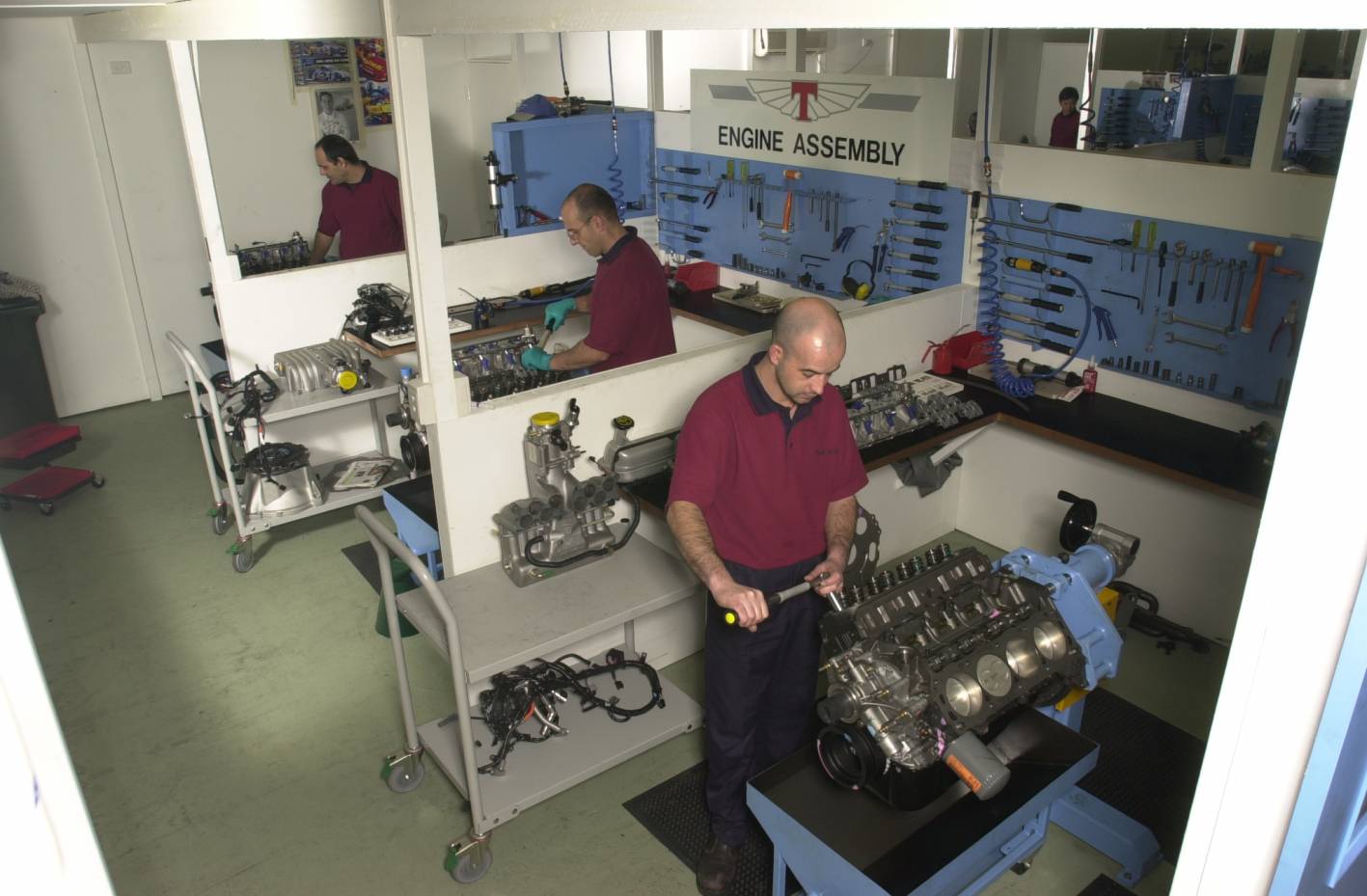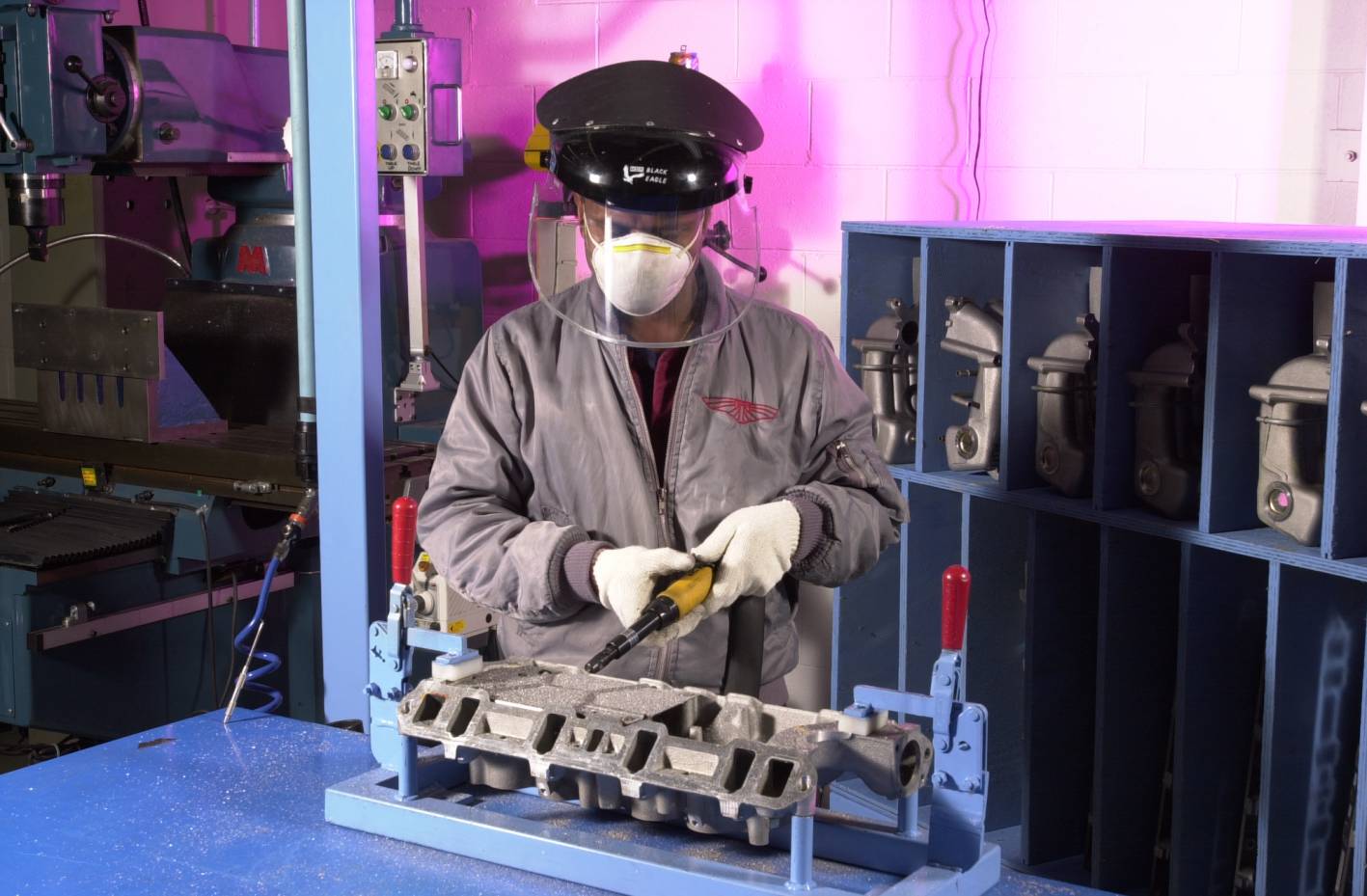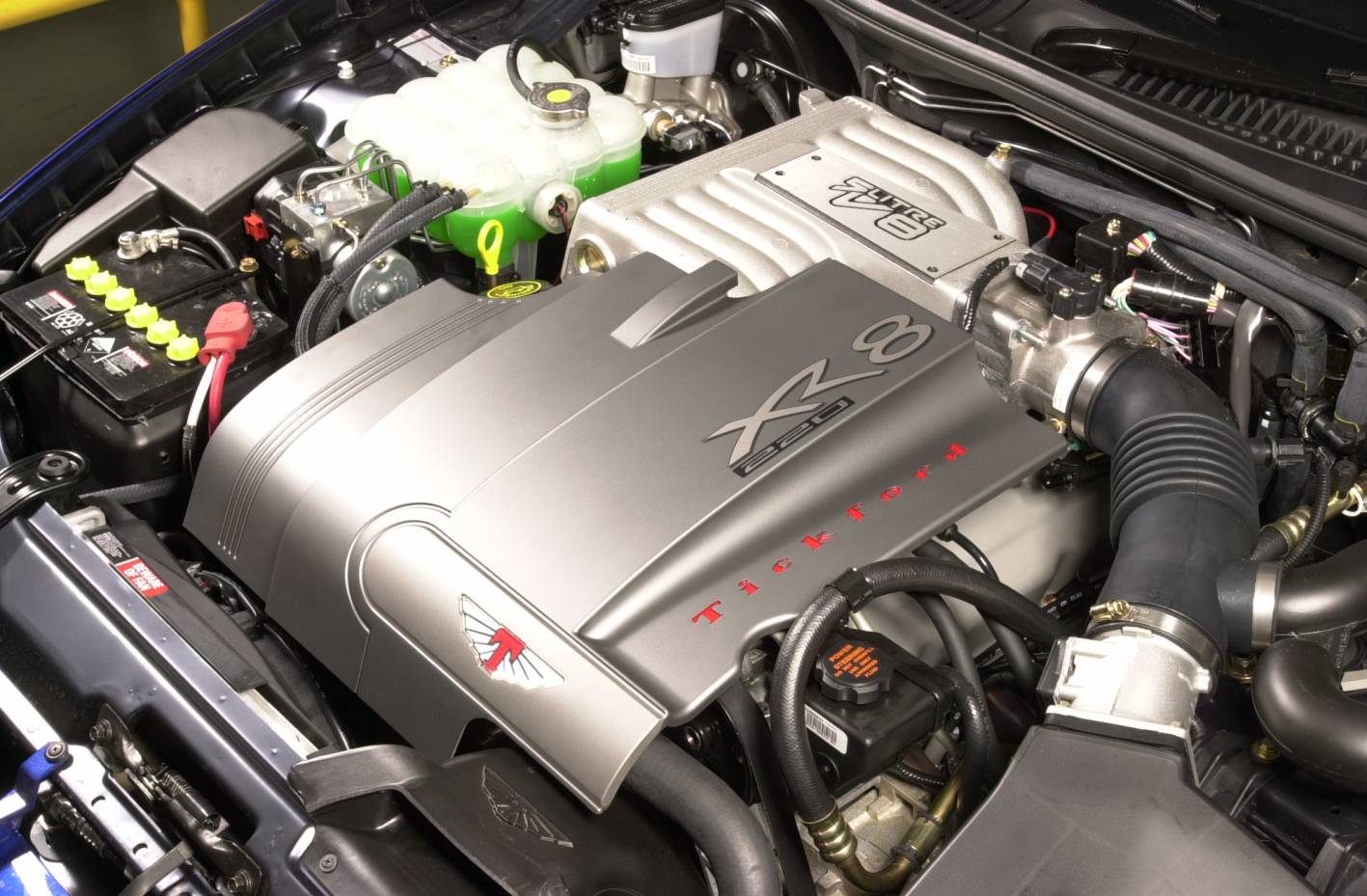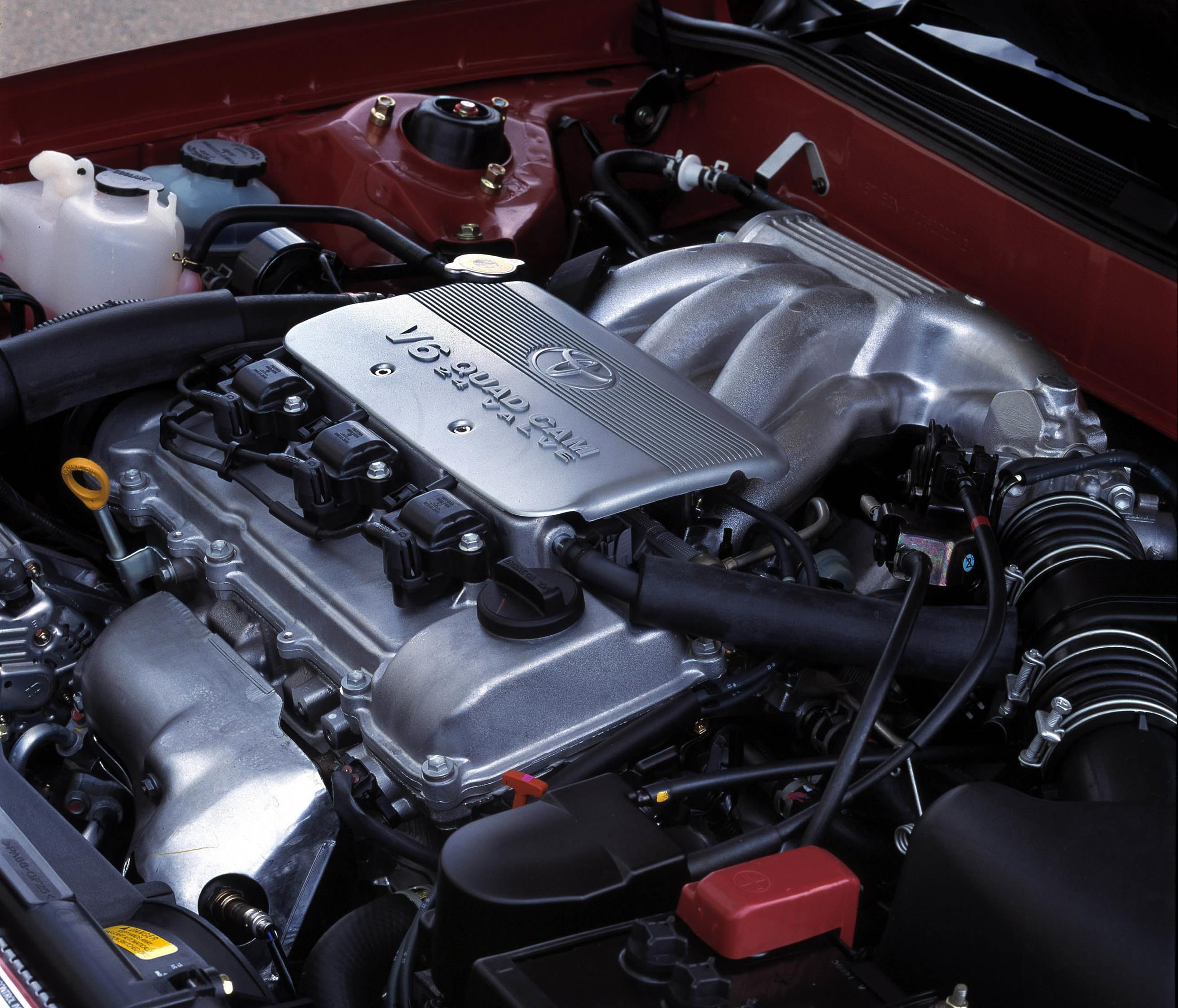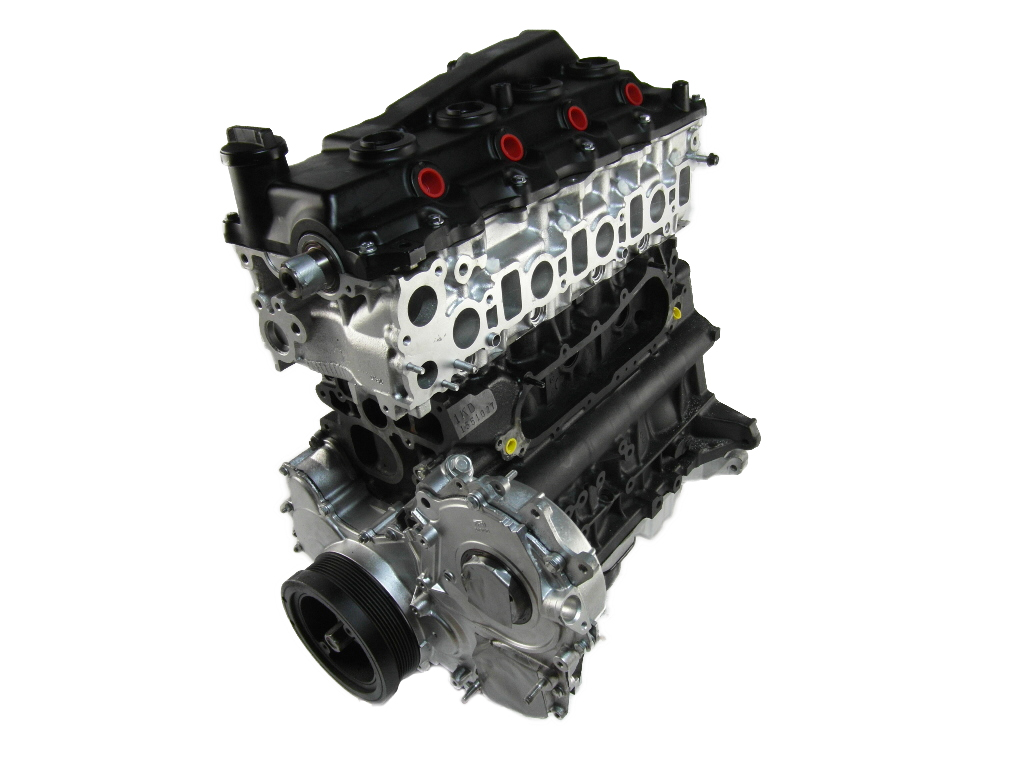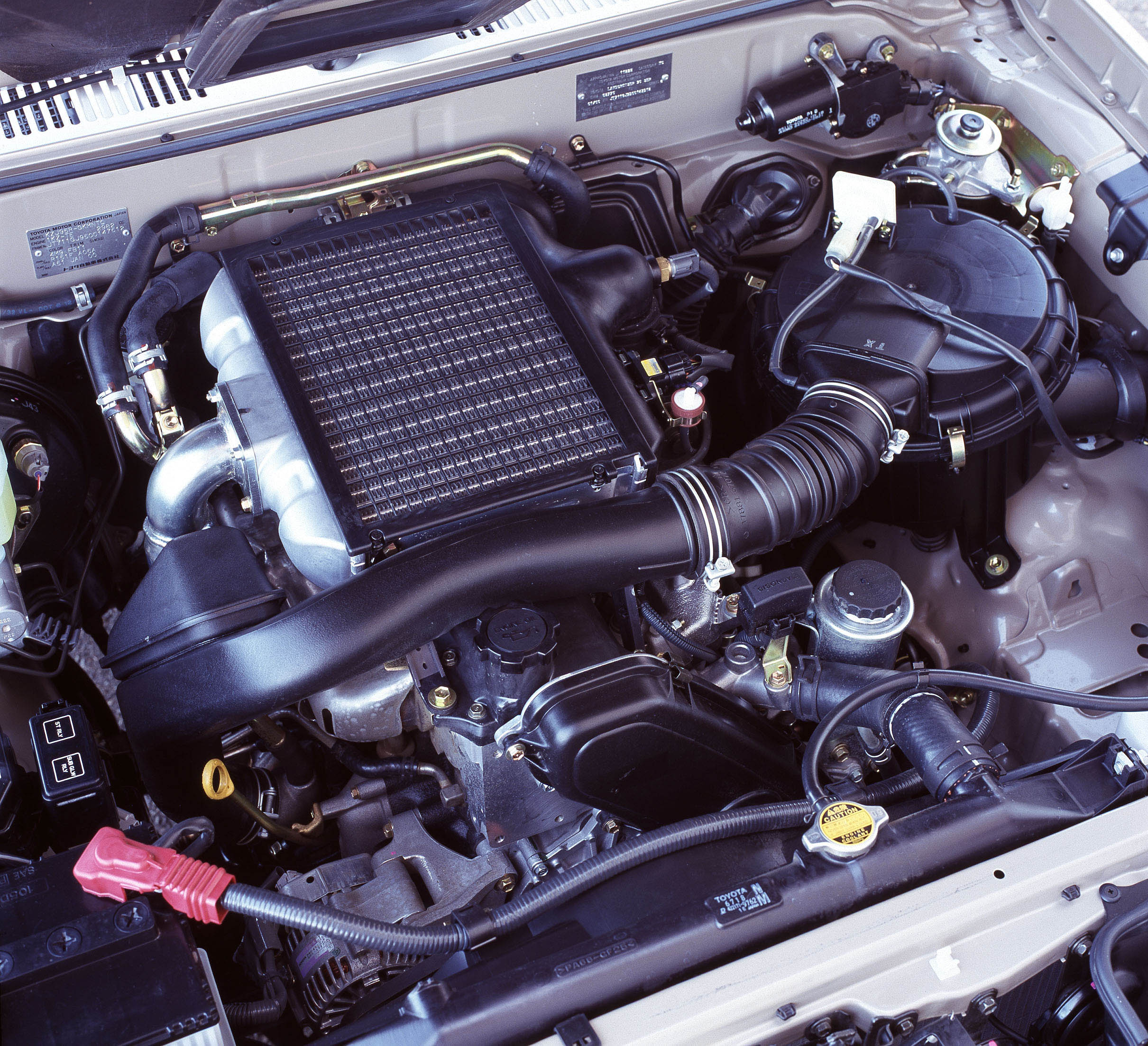Introduction
The 4.9-litre ‘Windsor V8’ was an overhead valve (OHV) engine with a 90-degree ‘V’ angle. For the AU range, the V8 engines were based on a later generation of the Windsor small block that was developed for the second generation, Ford Explorer (US Series: 2000-01). Compared to its predecessor, key developments for the AU’s Windsor V8 engine included:
- GT40P cylinder heads with centralised platinum spark plugs;
- An optimised camshaft;
- A new inlet manifold;
- A ‘high flow’ fuel intake system; and,
- Distributorless ignition.
For the Ford AU range, the Windsor V8 engine was offered in a range of different power outputs (see table below). This article will initially describe the 175 kW output Windsor V8 engine, then summarise the distinguishing features of the 185 kW, 200 kW and 220 kW versions. The stroked 5.6-litre Tickford V8 engine has been covered separately.
| Model | Engine | Trans. | Peak power | Peak torque | Years |
|---|---|---|---|---|---|
| Ford AU Falcon, Ford AU Fairmont |
4.9-litre petrol V8 | 4sp auto | 175kW at 4600rpm | 395Nm at 3200rpm | 1998-02 |
| Ford AU Fairlane & LTD | 4.9-litre petrol V8 | 4sp auto | 175kW at 4600rpm | 395Nm at 3200rpm | 1999-03 |
Cylinder block
The Windsor V8 engine had a cast iron block with 101.6 mm bores and a 76.2 mm stroke for a capacity of 4942 cc. As an overhead valve (OHV) engine, the camshaft was located inside the block and positioned close to the crankshaft so that it was driven by a shorter chain.
GT40P cylinder head
The Windsor V8 engine had a cast iron, cross-flow ‘GT40P’ cylinder head with two valves per cylinder and hydraulic lash adjusters to maintain zero valve clearance. For the 175 kW and 185 kW Ford AU V8 engines,
- The head of the intake valves had a diameter of 46. 7mm;
- The head of the exhaust valves had a diameter of 39.2 mm;
- Intake camshaft lobe lift was 6.698 mm;
- Exhaust camshaft lobe lift was 7.115 mm; and,
- Intake and exhaust valve lift was 11.227 mm;
In contrast to the GT40 heads, the ‘P’ in GT40P indicated a revised angle for the spark plug so that it was positioned nearer the centre of the combustion chamber for more efficient combustion. Furthermore, the design of the ports provided an intake flow of around 340 m3/hr (200 cfm) and exhaust flow of around 238 m3/hr (140 cfm).
Injection and ignition
The Windsor V8 engine had electronic multi-point fuel injection; pressure for the fuel system was 2.8 bar. Controlled by Ford’s ‘EEC V’ engine management system, the V8 engine had distributorless ignition via centralised platinum spark plugs that had 150,000 kilometre service intervals.
The firing order for the Windsor V8 engine was 1-3-7-2-6-5-4-8; for the 175 kW and 185 kW Ford AU V8 engines, the compression ratio was 9.1:1.
185 kW: Ford AU Falcon XR8
Compared to the standard 175 kW Windsor V8 engine, changes for the Ford AU.I Falcon XR8’s 185 kW engine included:
- A unique camshaft profile with a 1.6:1 rocker ratio (non-roller rockers);
- An aluminium trumpet device in the air filter to increase cold air flow;
- Tickford 4-into-1 exhaust headers;
- A ceramic coated exhaust manifold; and,
- A low back-pressure exhaust system.
| Model | Engine | Trans. | Peak power | Peak torque | Years |
|---|---|---|---|---|---|
| Ford AU.I Falcon XR8 | 4.9-litre petrol V8 | 5sp man., 4sp auto |
185kW at 5000rpm | 412Nm at 3500rpm | 1998-00 |
200 kW ‘Synergy 5000’: FTE T1 TE50/TL50 & AU.II Falcon XR8
The 200 kW ‘Synergy 5000’ V8 engine was initially offered in the Ford TE50 and Ford TL50 in October 1999, but was subsequently offered in the Ford AU.II Falcon XR8 from April 2000.
| Model | Engine | Trans. | Peak power | Peak torque | Years |
|---|---|---|---|---|---|
| Ford T1 TE50 | 4.9-litre petrol V8 | 5sp man., 4sp auto |
200kW at 5000rpm | 420Nm at 3750rpm | 1999-00 |
| Ford T1 TL50 | 4.9-litre petrol V8 | 4sp auto | 200kW at 5000rpm | 420Nm at 3750rpm | 1999-00 |
| Ford AU.II Falcon XR8 | 4.9-litre petrol V8 | 5sp man., 4sp auto |
200kW at 5000rpm | 420Nm at 3750rpm | 2000-01 |
- A larger air intake to enhance air flow;
- An F3ZE 6250 CA camshaft to improve top-end breathing (see below for valve timing);
- Lightweight ‘Ford Motorsport’ (FMS) aluminium roller rockers and needle roller bearings – these reduced friction and provided more reliable valve operation, especially at higher engine speeds. The Ford Motorsport roller rockers were produced by Crane Cams and had a 1.6:1 rocker ratio. It is understood that intake and exhaust camshaft lobe lift were both 7.169 mm; and,
- The compression ratio was reduced to 9.0:1.
Based on the table below, the 200 kW ‘Synergy 5000’ V8 engine had intake duration of 270 degrees, exhaust duration of 270 degrees and valve overlap of 33.50 degrees.
| 200kW Synergy 5000 – valve timing | ||
|---|---|---|
| Intake | Open | 19° BTDC |
| Close | 71° ABDC | |
| Exhaust | Open | 75.5° BBDC |
| Close | 14.5° ATDC | |
Hand-build process
Although based on the Windsor V8 engine, the 200 kW and 220 kW ‘Synergy 5000’ V8 engines were hand-modified by Tickford engine builders. For the 220 kW engine, this process included the following steps:
- The V8 engines were stripped down to a short block (i.e. block, pistons, connecting rods and crankshaft);
- The camshaft was then fitted;
- The sump, timing chain, timing chain cover and water pump were re-fitted;
- The new cylinder head was fitted;
- The lifters and pushrods were re-assembled, followed by the roller rockers;
- The injectors and wiring were re-attached to the lower intake manifold;
- A recalibrated fuel regulator for higher fuel pressure was fitted; and,
- The rocker covers were then re-assembled.
Each hand-modified engine hand a plaque for the engine builder to engrave his signature. The engines were then tested before being shipped to Ford’s Broadmeadows factory for installation.
220 kW ‘Synergy 5000’ with SVO Y303 head (1999-01)
The 220 kW ‘Synergy 5000’ V8 engine was initially offered in the Ford TS50 in October 1999, but subsequently powered the T2 TE50 and T2 TL50 (from October 2000).
| Model | Engine | Trans. | Peak power | Peak torque | Years |
|---|---|---|---|---|---|
| Ford T1 TS50 | 4.9-litre petrol V8 | 4sp auto | 220kW at 5250rpm | 435Nm at 4000rpm | 1999-01 |
| Ford T2 TS50 | 4.9-litre petrol V8 | 5sp man., 4sp auto |
220kW at 5250rpm | 435Nm at 4000rpm | 2000-01 |
| Ford T2 TE50 | 4.9-litre petrol V8 | 5sp man., 4sp auto |
220kW at 5250rpm | 435Nm at 4000rpm | 2000-01 |
| Ford T2 TL50 | 4.9-litre petrol V8 | 4sp auto | 220kW at 5250rpm | 435Nm at 4000rpm | 200-01 |
- An F1ZE 6250 AIA camshaft for increased lift and duration. Specifically, intake and exhaust camshaft lobe lift are understood to be 7.055 mm and 7.061 mm, respectively;
- Aluminium SVO Y303 cylinder head with flow-matched intake manifold. As described below, however, the aluminium SVO Y303 cylinder heads were discontinued in April 2001;
- Larger ports and valves. Specifically, the inlet and exhaust valves had 49.3 mm and 39.4 mm diameters, respectively (previously 46.7 mm and 39.2 mm);
- A larger, 70 mm diameter throttle body (compared to 65 mm) with revised throttle plate angle for better throttle response;
- Higher fuel pressure (3.5 bar, compared to 2.8 bar);
- A modified exhaust system with a low-restriction exhaust manifold;
- Higher flow catalytic converters (1.8 litre capacity, previously 1.3 litres); and,
- An engine oil cooler was fitted.
Based on the table below, the post-May 2001, 220 kW ‘Synergy 5000’ V8 engine had intake duration of 276 degrees, exhaust duration of 266 degrees and valve overlap of 39.00 degrees.
| 220kW Synergy 5000 – SV0 Y303 head: valve timing | ||
|---|---|---|
| Intake | Open | 20° BTDC |
| Close | 76° ABDC | |
| Exhaust | Open | 67° BBDC |
| Close | 19° ATDC | |
220 kW ‘Synergy 5000’ with GT40P head (2001-02)
In May 2001, the 220 kW ‘Synergy 5000’ engine was revised as the aluminium SVO Y303 cylinder head was replaced by the cast-iron GT40P head – this engine was introduced as a ‘running change’ for the FTE vehicles, though was the first Falcon XR8 to produce 220 kW. Other changes for this engine included,
- Yella Terra roller rockers were introduced with a rocker ratio of 1.72:1; and,
- The compression ratio was raised to 9.4:1.
| Model | Engine | Trans. | Peak power | Peak torque | Years |
|---|---|---|---|---|---|
| Ford T1/T2 TS50 | 4.9-litre petrol V8 | 4sp auto | 220kW at 5250rpm | 435Nm at 4000rpm | 2001 |
| Ford T2 TE50 | 4.9-litre petrol V8 | 5sp man., 4sp auto |
220kW at 5250rpm | 435Nm at 4000rpm | 2001 |
| Ford T2 TL50 | 4.9-litre petrol V8 | 4sp auto | 220kW at 5250rpm | 435Nm at 4000rpm | 2001 |
| Ford AU.II/AU.III Falcon XR8 | 4.9-litre petrol V8 | 5sp man., 4sp auto |
220kW at 5250rpm | 435Nm at 4000rpm | 2001-02 |
| 220kW Synergy 5000 – GT40P head: valve timing | ||
|---|---|---|
| Intake | Open | 15° BTDC |
| Close | 74° ABDC | |
| Exhaust | Open | 72° BBDC |
| Close | 22° ATDC | |


